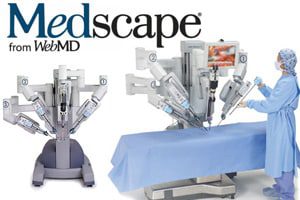
Although Intuitive Surgical, maker of the da Vinci robotic surgical system, continues to tout the controversial system’s so-called benefits, mounting injury reports and litigation tell a different story. Now, an editor and surgeon just published the slide show, “Robotic Surgery: Too Much, Too Soon,” on Medscape’s website, according to HealthNewsReview, in which a number of […]
 Although Intuitive Surgical, maker of the da Vinci robotic surgical system, continues to tout the controversial system’s so-called benefits, mounting injury reports and litigation tell a different story. Now, an editor and surgeon just published the slide show, “Robotic Surgery: Too Much, Too Soon,” on Medscape’s website, according to HealthNewsReview, in which a number of issues with the robotic system are highlighted.
Although Intuitive Surgical, maker of the da Vinci robotic surgical system, continues to tout the controversial system’s so-called benefits, mounting injury reports and litigation tell a different story. Now, an editor and surgeon just published the slide show, “Robotic Surgery: Too Much, Too Soon,” on Medscape’s website, according to HealthNewsReview, in which a number of issues with the robotic system are highlighted.
In robotic-assisted surgery, a surgeon sits at a console operating multiple robotic arms that manipulate tiny tools that are inserted into the patient’s body via small incisions. The system uses a small, lighted camera that displays the surgical area in 3-D video. The da Vinci is the only robotic surgery approved by the U.S. Food and Drug Administration (FDA) for soft tissue surgeries.
The slideshow cites, among other issues, the problem with insufficient training and noted that Intuitive is facing litigation involving surgeons who are not properly trained on the system, according to HealthNewsReview. J. Kellogg Parsons, MD, Associate Professor of Surgery, Department of Urology, Moores Cancer Center, University of California, San Diego, told Medscape “there is no standardized process for credentialing, teaching, proctoring, or obtaining hospital privileges for robotic-assisted surgery.” The Institute of Medicine and the FDA have both noted that the process by which new devices are approved should be revised.
Earlier this year, James T. Breeden, MD, President of the American Congress of Obstetrics and Gynecology (ACOG), issued a statement recommending against use of robotic systems in routine gynecologic procedures. He noted that research suggests that similar outcomes are realized in both robotic and laparoscopic hysterectomies; however, employing robotics increases surgical costs significantly, noted HealthNewsReview. A JAMA study revealed that it costs about $2189 more per case for robotically assisted hysterectomy when compared to laparoscopic techniques.
The slide show also discussed that the European Association of Urology (EAU) issued guidelines on robotic and single-site urology surgery, concluding that, “Robot-assisted urologic surgery is an emerging and safe technology for most urologic operations.” The authors noted, however, that research did not reveal better long-term effects on incontinence and erectile dysfunction. It also remains unclear, noted HealthNewsReview, if robotic surgery provided better results in most traditional procedures.
One of the more worrisome issues with robotics is its price point, with the machines costing $1.5-$2.2 each, according to the slide show. Add to that service contracts at $160,000-$170,000 annually, another $600-$1000 for disposable instruments that are used just once and which, per procedure, involve 3-8 instruments, the price per surgery is about 20 percent higher per robotic procedure, according to analysis published in March. Hospitals carry the burden of cost, wrote HealthNewsReview.
Recently, Intuitive Surgical dropped its stock price significantly in the face of stalled sales, a warning from federal regulators, and mounting injury reports and litigation.
As we’ve written, in the face of growing patient injuries, some hospitals are opting against using the technology, which is expensive. In fact, oncologist Dr. Ezekiel Emanuel, a former White House adviser, agreed with a 2012 op-ed piece published in The New York Times saying, “This is a pseudo-innovation … a technology that increases costs without improving patients’ health,” The Monterey Herald reported. According to Dr. Emanuel, a 2009 study revealed that although patients who underwent prostate surgery with the da Vinci experienced reduced hospital stays and less initial complications, such as blood loss, they experienced increased incontinence and erectile dysfunction later.
Personal injury lawsuits brought over the da Vinci allege that the system caused severe internal injuries such as burns, tears, and other complications. Some procedures have led to chronic pain, disability, or death. Lawsuits also blame Intuitive’s aggressive marketing tactics, which appear to be meant to urge hospitals to purchase the expensive robotic device, and allege that design flaws inherent in the da Vinci, as well as poor physician training on the device, have been tied to serious injuries. Some 89 deaths have been associated with the da Vinci robotic surgical systems since 2009.


